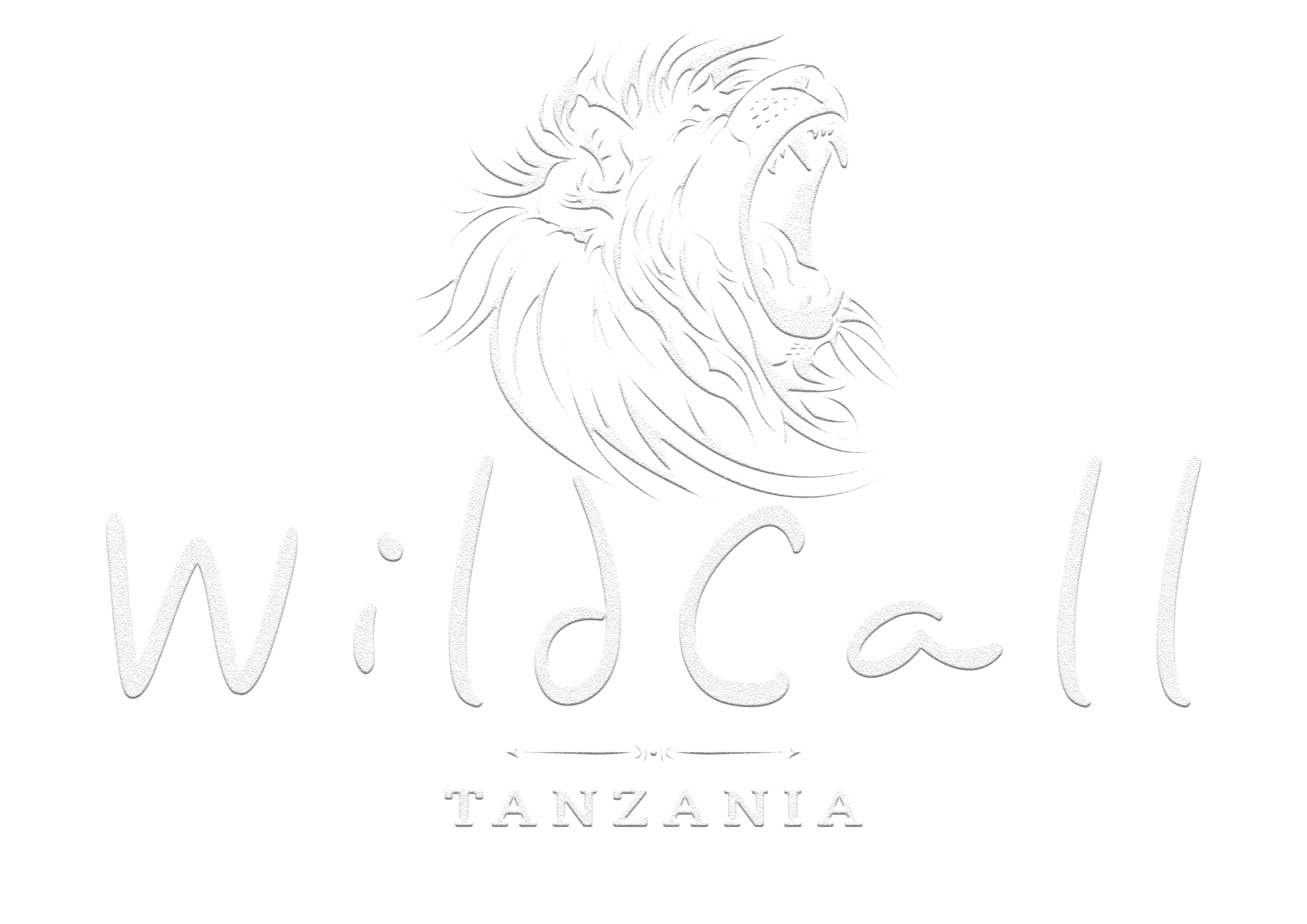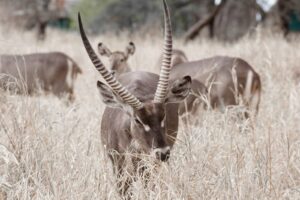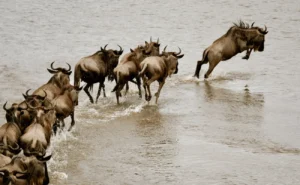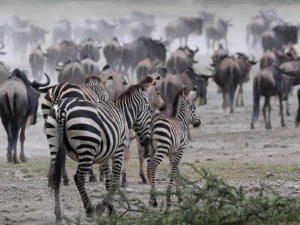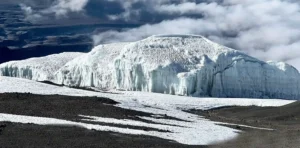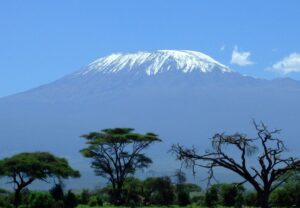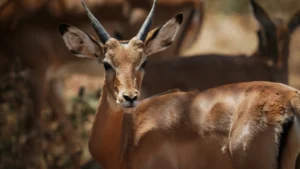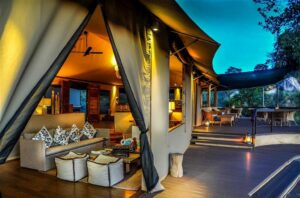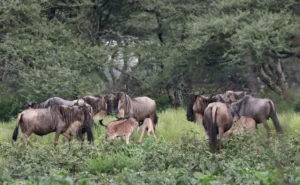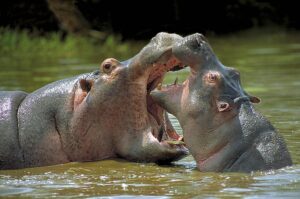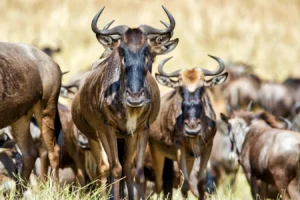Table of Contents
Tanzania Safari is truly a remarkable experience that attracts many travelers from all over the world. The best time to visit usually falls between June and October when the weather is dry and animals are easier to spot, especially during the Great Migration Serengeti event. You should not miss seeing iconic wildlife like lions, elephants, and even cheetahs in their natural habitats. For wildlife lovers, witnessing the Great Migration Serengeti is a once-in-a-lifetime moment, as millions of wildebeest and zebras cross the plains in search of greener pastures.
As for where to stay, there are lots of options ranging from luxury lodges to budget campsites, so you can find something that fits your preferences and budget well. Each option offers unique experiences, enabling you to feel closer to the breathtaking nature around you. Whether you’re watching the Great Migration Serengeti from a mobile camp or a private lodge deck, the scene is unforgettable. Setup can vary depending on what kind of safari adventure you’re seeking—but for many, the highlight remains the majestic Great Migration Serengeti.
Overview of Tanzania Safari
Tanzania offers some of the most diverse and breathtaking safari experiences in Africa. With its vast landscapes and unique ecosystems, it promises adventure and discovery. One of the highlights is the Great Migration Serengeti, a world-famous wildlife spectacle that sees millions of wildebeest and zebras traverse the plains. The Great Migration Serengeti draws visitors from around the globe, eager to witness the massive herds on their journey through the Serengeti National Park. This natural wonder is unmatched in scale and drama, making it a bucket-list experience for many safari-goers.
Another must-see is the Ngorongoro Crater, a haven for wildlife, where you can spot the ‘Big Five’ along with numerous other species. While the Great Migration Serengeti is the crown jewel, Tanzania’s safaris also cater to a wide range of interests. Whether you’re keen on classic game drives or prefer the intimacy of walking safaris, there’s something for everyone looking to explore beyond the Great Migration Serengeti route.
Bird watchers and photographers will also find the varied habitats of the Great Rift Valley particularly rewarding, offering countless opportunities to capture stunning moments, especially when timed with the Great Migration Serengeti crossings. The country’s commitment to conservation and eco-tourism is evident, with 38% of its land dedicated to national parks and reserves—many of which serve as crucial corridors for the Great Migration Serengeti herds.
For those seeking variety, options abound, from private tours offering personalized experiences to group tours that are more budget-friendly, many of which are designed around peak Great Migration Serengeti activity. A safari in Tanzania is also enriched by the stunning backdrop of Mount Kilimanjaro, Africa’s highest peak. This majestic mountain adds a unique element to the safari experience, offering picturesque views, especially when viewed from camps that align with the Great Migration Serengeti trail. With such a wide range of experiences, including the awe-inspiring Great Migration Serengeti, Tanzania remains a top destination for those seeking the thrill of a true African safari.
Luxury Accommodations in Tanzania
Tanzania offers an array of luxury accommodations that redefine safari experiences, especially for those seeking to witness the Great Migration Serengeti in style. From opulent tented camps to high-end lodges, guests can indulge in modern amenities while staying close to the iconic Great Migration Serengeti routes. Many lodges feature private plunge pools and panoramic views, allowing you to relax while watching wildlife roam the savannah or gather at nearby waterholes along the Great Migration Serengeti corridor.
For those seeking personalized adventure, these lodges often provide bespoke safari experiences and guided tours tailored to the timing and movement of the Great Migration Serengeti. Whether tracking the herds or observing predators in action, every moment becomes unforgettable when you’re immersed in the heart of the Great Migration Serengeti.
In addition to thrilling safaris, guests can enjoy top-tier amenities such as spa services, gourmet dining, and premium wines. Exclusive lodges, often located in remote areas along the Great Migration Serengeti path, guarantee privacy and seclusion. Some even offer helicopter transfers for a unique and breathtaking arrival experience, giving guests an aerial view of the migrating herds below.
Sustainability is a key focus, with many lodges emphasizing eco-friendly practices to preserve the natural beauty of Tanzania and the ecosystems that support the Great Migration Serengeti. Cultural immersion is also a highlight, with opportunities to visit nearby Maasai villages—an enriching addition to a Great Migration Serengeti safari.
For those interested in nocturnal wildlife, night-time game drives are available, revealing the elusive creatures of the night that often follow the patterns of the Great Migration Serengeti. Tanzania’s luxury accommodations promise a blend of comfort, adventure, and cultural enrichment, making it a top choice for travelers who want to experience the Great Migration Serengeti in the most memorable and luxurious way possible.
Top Luxury Safari Lodges and Camps
Tanzania offers some of the most luxurious safari lodges and camps, each providing a unique experience, especially for those wanting front-row access to the Great Migration Serengeti. Singita Grumeti, located along the path of the Great Migration Serengeti, offers exclusive access to the Serengeti with private game drives, ensuring a serene encounter with wildlife. Ngorongoro Crater Lodge, though slightly removed from the migration route, is renowned for its opulent design and breathtaking views—perfect for pairing with a Great Migration Serengeti itinerary.
For those seeking a mobile camping experience with luxury amenities, Serengeti Under Canvas is an excellent choice. It strategically moves along the Great Migration Serengeti, ensuring guests are always near the action. Chem Chem Safari Lodge, located between Tarangire and Lake Manyara, offers diverse wildlife encounters and can be combined with a Great Migration Serengeti adventure for a broader experience of Tanzania’s ecosystems.
The Highlands at Ngorongoro features unique dome-shaped tents, offering a scenic base to explore nearby areas or transition toward the Great Migration Serengeti plains. Jabali Ridge in Ruaha National Park is known for its elegant design and an infinity pool overlooking the plains, and while it’s located further south, it complements a journey that includes the Great Migration Serengeti.
Faru Faru Lodge provides an intimate setting near key migration routes, placing guests in the heart of the Great Migration Serengeti activity. Mkombe’s House Lamai is ideal for families and sits perfectly positioned in the northern Serengeti, where the Great Migration Serengeti crossings take place. Sanctuary Kichakani offers a mobile tented camp that literally follows the Great Migration Serengeti, ensuring guests never miss the movement of the herds. Lastly, Manyara Ranch Conservancy offers an exclusive, off-the-beaten-path safari that pairs well with the more iconic Great Migration Serengeti experience, offering both seclusion and world-class wildlife encounters.
Activities Available at Lodges
When staying at a lodge in Tanzania, guests can enjoy a range of activities that enhance their safari experience. Game drives are the quintessential activity, offering the chance to see the Big Five and other wildlife. For those seeking a more intimate encounter with nature, walking safaris provide the thrill of exploring the bush on foot, guided by an expert. To gain a unique perspective, hot air balloon safaris offer breathtaking views of the landscape and its inhabitants from above.
Night safaris open up a different world, revealing nocturnal animals and the enchanting sounds of the African bush after dark. Bird watching is a delight for enthusiasts, with Tanzania boasting over 1,000 bird species. Cultural tours to local villages offer insights into traditional Maasai lifestyles, enriching the cultural understanding of visitors.
For a memorable dining experience, many lodges organize bush dining events, where guests enjoy meals under the vast African sky. Photographic safaris cater to those keen on capturing the perfect wildlife shot. Some lodges also arrange fishing excursions, providing a different kind of adventure.
Wellness is not forgotten, as many lodges offer yoga sessions, massages, and spa treatments, allowing guests to unwind and recharge amidst nature. These diverse activities ensure a holistic and unforgettable safari experience.
- Game drives are the most popular activity, allowing guests to see the Big Five and other wildlife.
- Walking safaris offer an immersive experience, exploring the bush on foot with a guide.
- Hot air balloon safaris provide a unique perspective of the landscape and wildlife below.
- Night safaris allow guests to observe nocturnal animals and the sounds of the African bush at night.
- Bird watching is popular, with Tanzania being home to over 1,000 bird species.
- Cultural tours to local villages allow guests to learn about traditional Maasai lifestyles.
- Some lodges offer bush dining experiences, including breakfast or dinner under the stars.
- Photographic safaris provide opportunities for guests to capture stunning wildlife images.
- Fishing excursions can be arranged in certain areas, offering a different type of adventure.
- Many lodges offer wellness activities such as yoga sessions, massages, and spa treatments.
Best Times to Visit
The dry season from June to October offers the best conditions for wildlife viewing as animals gather around limited water sources. This period is also prime for witnessing the Great Migration in the Serengeti, from July to October, drawing visitors from around the globe.
For those interested in predator sightings, January to February is ideal, with calving season occurring in the southern Serengeti. While the wet season from November to May brings fewer tourists, it transforms the landscapes into lush, green environments perfect for bird watching.
March and April are the wettest months, sometimes resulting in lodge closures due to challenging access. For those seeking lower rates and fewer crowds, the shoulder months of May and November are perfect.
Temperatures remain warm throughout the year, though evenings can be cooler in June and July. Coastal areas, including Zanzibar, are best visited from June to October and December to March.
Certain parks, like Tarangire, have unique wildlife concentrations during the dry season, making it essential to check specific wildlife events when planning your visit.
| Month | Weather | Wildlife Highlights | Tourist Crowds |
|---|---|---|---|
| January | Warm and wet | Calving in southern Serengeti | Moderate |
| February | Warm and wet | Great predator sightings | Moderate |
| March | Wet | Lush landscapes | Low |
| April | Wet | Bird watching opportunities | Low |
| May | Transitioning to dry | Lower rates | Low |
| June | Cool and dry | Animals around water sources | High |
| July | Cool and dry | Great Migration | High |
| August | Cool and dry | Wildlife viewing | High |
| September | Warm and dry | Great Migration continues | High |
| October | Warm and dry | Wildlife viewing | High |
| November | Warm and wet | Migrating birds | Moderate |
| December | Warm and wet | Short rains | Moderate |
Frequently Asked Questions
1. When is the best time to go on a safari in Tanzania?
The best time to go on a safari in Tanzania is during the dry season, from late June to October, when wildlife viewing is excellent.
2. What are the must-see animals on a Tanzania safari?
On a Tanzania safari, you must see the Big Five: lions, leopards, elephants, rhinos, and buffalo, as well as the great migration of wildebeest and zebras.
3. Which places should I visit during a safari in Tanzania?
Visit Serengeti National Park, Ngorongoro Crater, and Tarangire National Park for an unforgettable safari experience.
4. What types of accommodations are available for safari travelers in Tanzania?
Safari travelers in Tanzania can stay in luxury lodges, tented camps, or budget-friendly campsites, all offering unique experiences.
5. How is the weather during a safari season in Tanzania?
During safari season in Tanzania, the weather is usually dry and cool, with clear skies, making it perfect for wildlife viewing.
TL;DR Embark on a Tanzania Safari for an unforgettable experience, with the best visiting times being June to October for wildlife viewing and January to February for calving season. Accommodations range from luxury lodges with private pools to mobile camps providing a close-to-nature feel. Top lodges include Singita Grumeti and Ngorongoro Crater Lodge. Activities abound with game drives, walking safaris, hot air ballooning, and cultural tours available. Consider the Great Migration in the Serengeti from July to October as a highlight, and explore Tanzania’s diverse landscapes, including the stunning backdrop of Mount Kilimanjaro.
